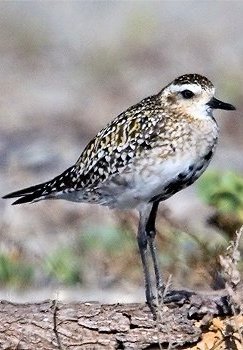
|
Shorebird Migration
Shorebirds, like most of our waterfowl, nest on th arctic tundra and migrate to southern wintering grounds. Yet unlike waterfowl, many shorebirds -- sandpipers, plovers, godwits, curlews --- migrate beyond the confines of the North American continent. A classic example is the Lesser Golden Plover, which spends the northern winter on the vast Argentinian grasslands called the pampas. There, along with its fellow migrants -- yellowlegs, Hudsonian Godwits, stilts, and Baird's, Pectoral, Upland, and Buff-breasted Sandpipers -- the Lesser Golden-Plover spends the southern summer with resident South American shorebirds. In spring the golden-plovers migrate northward in flocks, crossing the Caribbean and Gulf of Mexico. They enter the United States mainly along the Texas and Louisiana coasts, and head up through the interior of North America, stopping to feed on insects in pastures and plowed fields of the agricultural Midwest. These long-distance migrants arrive in their breeding grounds in June, and nest during the long days of the brief northern summer. Young shorebirds are precocial (capable at birth). Little parental care seems to be required in many of these species. In fact, the adult birds depart on their southward migration before summer is over, weeks before their youngsters begin their trip. Though golden-plover migrate a bit later, the height of their passage period of many adult shorebirds in the eastern United States occurs from late July through August. In midsummer they reappear, well on their way to the wintering ground. The precocial young birds appear some weeks later, guided southwards by their instincts. Migration Paths of the Lesser Golden-Plover |
| The Lesser Golden-Plover | |
|
During the crossing, the golden-plovers ascend to great heights (over 20,000 feet), but it still takes several days and nights of continuous flying before they reach the continent. Return to Bird Migration and Navigation |
|